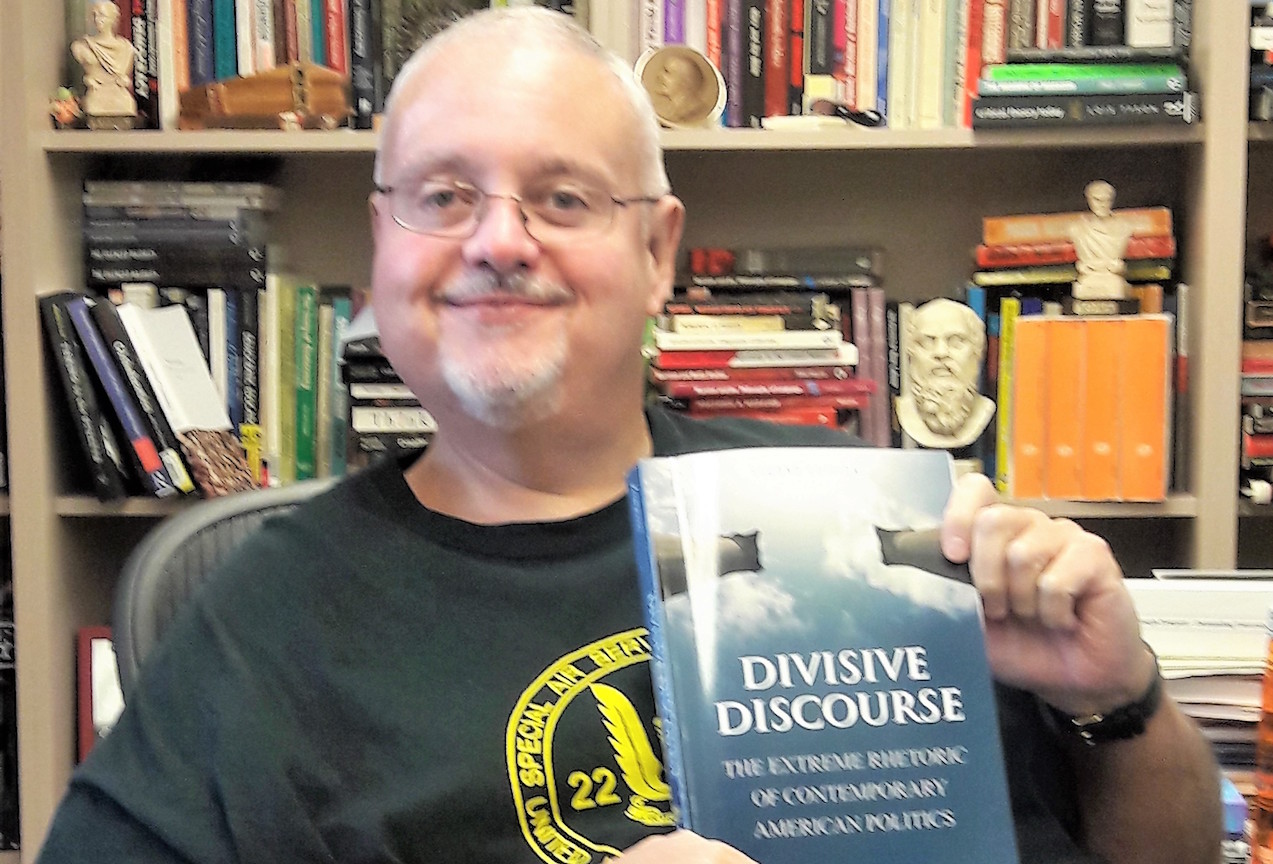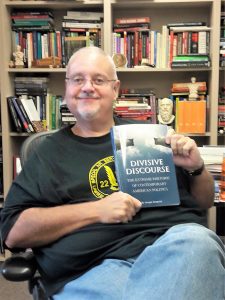The lack of unity within American politics is a growing problem. From the dysfunction in Washington, D.C., to average citizens speaking out against a broken system, the United States is becoming more divided.
Many people want to understand how the American political system has become so divisive. Clearly, there are social pressures imposed on people involved with politics to align with either Democratic or Republican groups. While Americans spend a lot of time supporting only one side of the political spectrum, they often speak poorly about those on the opposite side. Therefore, division is caused by the ways average people communicate about politics.
“What came as kind of a shock to me is that most people, both in the political science and communication worlds, don’t really focus on the communication part,” said School of Communication Professor Joseph Zompetti.
Zompetti has been a long-standing professor within ISU’s School of Communication. His research expertise involves rhetorical theory and political communication. Additionally, Zompetti has years of experience competing and coaching collegiate-level debate.
While teaching and researching political communication at ISU, Zompetti stumbled across a book called Wingnuts by John Avlon. Avlon’s book discusses how prominent political figures and commentators— referred to as “Wingnuts”— fall on extreme sides of the political spectrum and hijack American political discourse. Overall, its central idea discusses how political figures become talking heads of the nation and maintain a dominant influence in mainstream political conversations.
Zompetti, however, recognized political divisions within discussions of average people. “What Avlon’s book does not explain is how ordinary, common people communicate about politics,” said Zompetti, “I realized that there needs to be an explanation as to how real people discuss political information.”
This insight encouraged Zompetti to write a book entitled Divisive Discourse, which describes a communicative phenomenon called polarization. Overall, the book interrogates the understanding of polarized rhetoric and explains how the extremist language and behaviors embedded within it divide average people.
According to Zompetti, polarization is a complex phenomenon, but it is essentially the extreme divide between liberal and conservative ideologies. This divide is widening based on the competitive, “us-versus-them” mentality communicated to political audiences. These mentalities are often stubborn, aggressive, and fail to include other perspectives. Several communicative factors within American society that have contributed to this divide are addressed in Divisive Discourse.
In the introduction of Divisive Discourse, Zompetti states, “Politics is about words and power.” Today, political conversations remain polarized because people in positions of power display their opinions to large audiences. These opinions tend to be extremist and dominate political conversation. More importantly, the messages conveyed by individuals or institutions that wield political power to influence the behavior of average people.
This is a problem because much of the rhetoric displayed by political figures is fueled with negativity which reinforces division. Zompetti referred to the most recent 2016 election and explained that both Donald Trump and Hillary Clinton’s campaigns relied on forms aggressive forms of negative rhetoric.
“Here we have political candidates who are engaging in rhetoric filled with insults intended to damage the reputation of the opposite side,” said Zompetti. From the Trump campaign’s constant references to Clinton as “Crooked Hillary” and Clinton’s description of Trump supporters as “a basket of deplorables,” both sides have clearly relied on a repetitive exchange of insults rather than discussing crucial issues.
Beyond the 2016 election, the use of combative language has become increasingly more frequent in American politics. While many claim that divisive rhetoric is ineffective, it still persists with more intensity every election year.
Consider the harsh advertisements produced by political campaigns. “Although most Americans claim to dislike negative campaigns, many studies suggest that they are effective,” said Zompetti. “People either mimic these behaviors or are completely shut off.” Therefore, it seems that negative rhetoric has remained dominant and repeated by the public. Meanwhile, other reasonable opinions remain silent and uninfluential. Thus, polarization is reinforced.
Much of this negativity is supported because it gains attention through superficial content that is quick and easy to comprehend. Divisive Discourse points to America’s news media as one reason for the increase in polarization. The news media’s 24/7 news cycle and various social media formats thrive off of disseminating short, quick and easy-to-read information. However, the brevity of these messages often lack accuracy and necessary depth.
Zompetti explained that news media messages are shortened and riddled with “buzzwords” to capture the most attention possible from an audience. However, since these messages are less in-depth, they are also likely to contain false statements. This is why information is frequently misguided or false in the media.
“News is now the shallowest it’s ever been on mainstream media and we simply don’t have reporters talking about facts,” said Zompetti. When Americans read, watch, or listen to political commentary on the news, they often receive oversimplified versions of the truth. This makes it easy for people to blindly pick sides to an issue.
Mass media is also a business at the end of the day. News conglomerates have become problematically competitive and focus on being the first to publish a story rather than the accuracy or depth of its information. Meanwhile, negative and extremist political language is utilized for attention-getting purposes to maintain profitable ratings. As long as the industry remains profitable, it is likely that polarized perspectives will remain dominant.
Although powerful political figures and media institutions contribute to mainstream polarization, the larger issue in Divisive Discourse explains how this influence affects the behaviors of average American citizens. “A majority of Americans generally have moderate political beliefs, but the way they discuss them is often polarizing,” said Zompetti. This is because polarized discourse presents itself more impactfully through the delivery of our messages rather than the content itself.
“However, people in our current social-political climate believe their opinion or way of thinking is always 100 percent right and the opposition is always 100 percent wrong,” said Zompetti. This competitive “us versus them” dichotomy has caused people to avoid alternative opinions, even if those opinions would result in constructive outcomes.
A common result of this attitude is political gridlock. From congress to average citizens, uncooperative behavior is abundant in politics. Gridlock ultimately produces negative effects for American citizens at national and local levels. Consider the recent enactment of Illinois’ state budget, which remained unrevised for two years due to bipartisan bickering. During this gridlock, residents of Illinois experienced a series of layoffs at various higher education institutions, the closure of six drug and alcohol rehabilitation programs, and several other community social service providers struggled to stay open.
Unfortunately, negative rhetoric, superficial news messages, and the failure to listen to the opinions of others has resulted in tension, incivility, and division between groups of people. Left unmonitored or unresolved, these tensions have proven to result in violence.
These intergroup tensions can be seen within race relations which have historically and recently experienced violence due to political divisiveness. In most recent news, the hateful and violent white nationalist protests in Charlottesville exemplify clear tensions that divide racial groups. In regard to the civility of our country, racial prejudice remains a catalyst for violent outcomes because people fail to communicate effectively and understand issues involved with race.
Issues of violence and incivility extend beyond race relations and into all facets of political difference. For example, this summer’s shooting at a charity baseball practice hosted by Republican members of congress was motivated by left-wing extremism. In other words, polarization and extreme opinions can lead to violent outbreaks. If polarization continues, so will violence.
The larger idea of Divisive Discourse encourages people to understand difference while communicating about politics. When people participate in polarization through harsh rhetoric, people fail to understand the importance of difference. Overall, people need to learn how to communicate peacefully and reasonably with those who hold different political beliefs and perspectives.
In order to do this, people need to change the way they talk about politics. Americans need to realize that negative rhetoric is simply a persuasive tool for political figures to maintain power through public support. It does not provide actual solutions to the nation’s issues. Rather, it divides American citizens into fusses of extreme opinions that support the agendas of those in political power. Therefore, Americans must avoid negative rhetoric in order to make reasonable and independent decisions.
People must also become less stubborn with their political beliefs. Divisive Discourse encourages people to keep an open mind while encountering different opinions. This can be accomplished by eliminating personal bias and staying informed about an issue from multiple sides. “Value can still be found in messages delivered with harsh rhetoric and opposing views. But, if we don’t listen to other views and remain in gridlock, all we are doing is sacrificing our rights to people in power,” explained Zompetti.
However, Zompetti suggests that the most important thing to do while discussing politics is to listen. Divisive Discourse explains that political conversations will continue to be dysfunctional unless people can learn from one another. This means that people must not only change the way they convey their own political opinions, but also must take the time to listen and understand another’s point of view.
At the end of the day the answers to our nation’s problems are found through communicative unity. Adjusting our communication to understand and cooperate with difference provides more long term benefits for society. Negative rhetoric only instigates controversy and people fail to be productive members of society through superficial bickering, aggression, violence, and other forms of divisive discourse. Overall, the solution to political divisiveness can begin if people become more understanding, open, and patient within their communication.
Through Divisive Discourse, Zompetti envisions a brighter and more unified country. By addressing the communicative issues of polarization within our country’s political climate, Americans can begin to come together. “At the end of the day, democracy matters and we all have a role to play,” said Zompetti, “which means we all need to talk about it—and talk constructively and with civility.”
To find out more about Zompetti and Divisive Discourse, visit the publisher’s website here.
About The School of Communication
The School of Communication at Illinois State University dates back to 150 years of academic excellence. The School’s mission is to better Illinois’ job market by supplying its students with
the opportunity to pursue undergraduate and graduate degrees, research and service initiatives that are at the cutting edge of theory and translate into meaningful careers. For more information, please visit us at communication.illinoisstate.edu.


